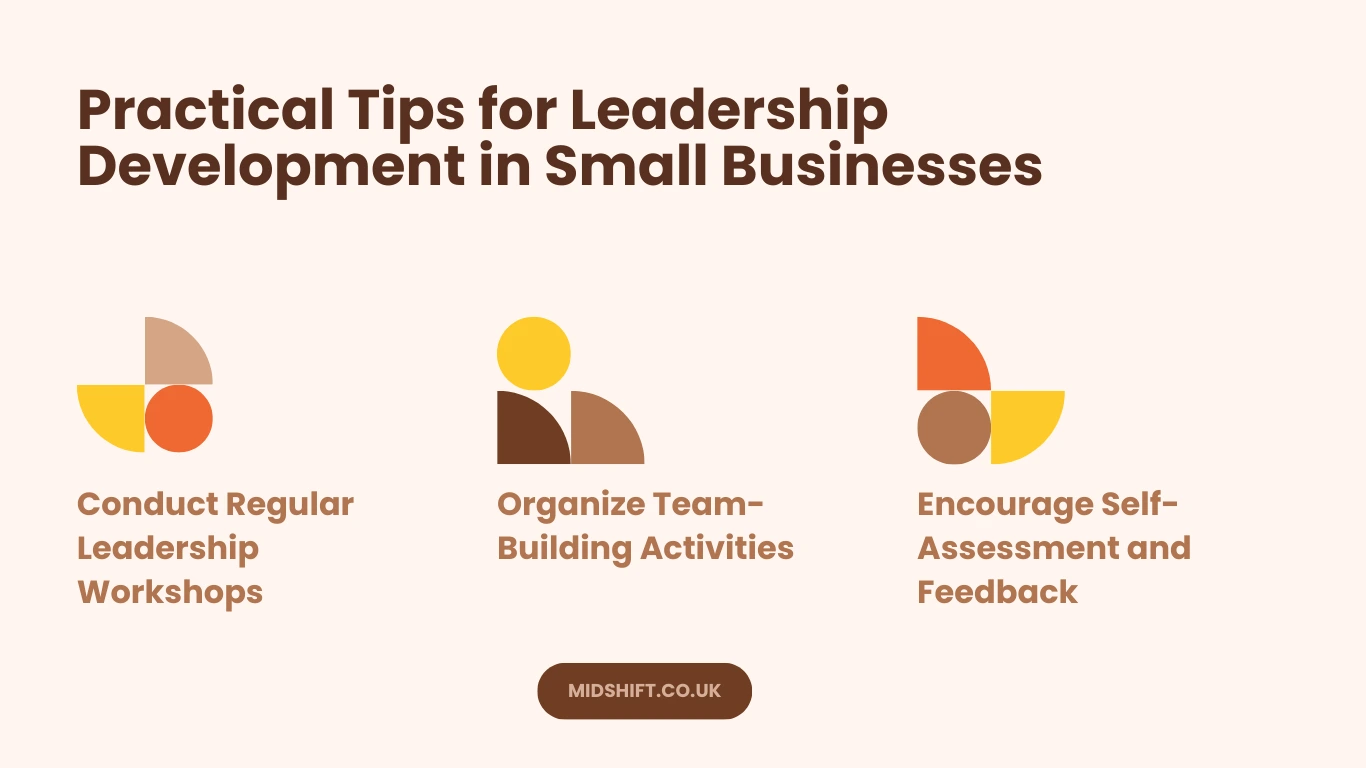Leadership team development might sound like a concept reserved for large corporations, but small businesses stand to gain even more from it. Why? Because in a small business, every decision, action, and collaboration has an amplified impact. Yet, many small business leaders overlook the power of nurturing their leadership team, thinking it requires vast resources or complex strategies. The truth is, small steps can lead to big changes. By investing time and effort into developing your leadership team, you can unlock untapped potential, foster innovation, and steer your business toward sustainable growth.
To learn more about the benefits of leadership team development for small business, check out this inspiring guide: Benefits of Leadership Team Development. Discover practical strategies and success stories to inspire your next steps.
Effective Leadership Training Programs for Small Teams
Developing effective leadership training programs for small teams doesn’t have to be complicated or costly. Start by identifying the core skills your team needs to succeed—such as communication, decision-making, and conflict resolution. Next, design training sessions that fit your team’s schedule and resources. For example, instead of expensive external workshops, consider in-house training sessions where team members role-play common scenarios or discuss real-life challenges they’ve faced.
An example: A small marketing agency created a monthly “Leadership Roundtable.” Each session focused on one skill, like managing deadlines under pressure. Team members shared their approaches, and the group collaboratively built a best-practice guide. These sessions not only enhanced skills but also strengthened team collaboration.
Looking for tools to enhance your training programs? Explore this comprehensive guide: Best Leadership Team Development Assessment Tools 2025. It offers insights into tools designed to help small businesses assess and strengthen their leadership teams effectively.
Practical Tips for Leadership Team Development for Small Businesses
Leadership team development for small businesses doesn’t have to be overwhelming. By focusing on simple, actionable strategies, you can build a culture of growth and empowerment. Here are eight practical tips to get started:
1. Conduct Regular Leadership Workshops
Host workshops that address essential leadership skills like communication, decision-making, and conflict resolution.
Example: A small business owner can organize monthly sessions where team leaders learn effective communication techniques through hands-on activities.
2. Implement Mentorship Programs
Pair experienced leaders with emerging talents to foster knowledge-sharing and personal growth.
Example: A senior manager mentors junior employees, guiding them through real-world challenges and enhancing their leadership potential.
3. Leverage Online Leadership Courses
Invest in affordable, high-quality online courses covering strategic planning or emotional intelligence.
Example: Enroll your team in platforms like Coursera or LinkedIn Learning to strengthen their leadership capabilities.
4. Encourage Self-Assessment and Feedback
Create opportunities for leaders to assess their skills and gather constructive feedback.
Example: Schedule regular 360-degree feedback sessions to help leaders identify strengths and improvement areas.
5. Organize Team-Building Activities
Promote collaboration through engaging group activities that enhance teamwork.
Example: Plan an offsite retreat with trust-building exercises and problem-solving challenges.
6. Start a Leadership Book Club
Foster learning and discussion by reading and sharing insights from leadership books.
Example: Choose one leadership book monthly, and hold discussions to connect the concepts to workplace scenarios.
7. Use Role-Playing Scenarios
Simulate real-life challenges with role-playing exercises to improve problem-solving and decision-making.
Example: Create scenarios where leaders practice handling difficult conversations or navigating high-pressure decisions.
8. Attend Networking Events
Broaden perspectives and gain insights by participating in industry conferences and networking sessions.
Example: Encourage your team to join local business groups or attend leadership seminars to learn from other professionals.
Interactive Leadership Games for Skill Building
Leadership games provide a dynamic way to develop essential skills like communication, teamwork, and strategic thinking. Imagine a group of professionals, all working together towards a common goal, navigating challenges and growing as leaders in the process. These activities are not only fun but are key to fostering collaboration and problem-solving. For example, virtual team-building activities for small teams are a great way for small teams to connect and develop these skills in a remote or hybrid setting. These free, easy-to-use games can break down barriers and create a sense of unity in any team. Now, let’s dive into some leadership games that you can use to build these skills effectively.
The Leadership Race
Objective: Improve decision-making and strategic thinking.
Activity: Design a racecourse with obstacles that require strategic decisions to overcome.
Example: Teams face scenarios like budget cuts or market changes and decide the best actions to continue the race.
The Marshmallow Challenge
Objective: Enhance teamwork and creative problem-solving.
Activity: Teams use spaghetti, tape, string, and a marshmallow to build the tallest structure in 18 minutes.
Example: This fosters quick thinking and collaboration under pressure.
Role Reversal
Objective: Develop empathy and understand different roles within the team.
Activity: Team members switch roles for a day. Leaders take on team tasks and vice versa.
Example: A manager works in customer service, gaining insight into daily challenges faced by the team.
The Blindfold Challenge
Objective: Improve communication and trust.
Activity: One member is blindfolded, and the team guides them through an obstacle course using only verbal instructions.
Example: This highlights the importance of clear, concise communication.
The Tower Building Game
Objective: Foster collaboration and strategic planning.
Activity: Teams use materials like blocks or straws to build the tallest tower within a time limit.
Example: Teams practice delegation and strategic execution.
The Leadership Scavenger Hunt
Objective: Enhance problem-solving and teamwork.
Activity: Create a scavenger hunt with leadership-related challenges and clues.
Example: Clues involve scenarios like resolving conflicts or making strategic decisions.
The Balloon Balance Challenge
Objective: Improve coordination and adaptability.
Activity: Teams must keep multiple balloons in the air without letting them touch the ground.
Example: This requires leaders to quickly adapt to shifting priorities.
Two Truths and a Leadership Lie
Objective: Build rapport and identify leadership qualities.
Activity: Team members share two truths and one lie about leadership experiences. The team guesses which is the lie.
Example: This helps leaders reflect on their experiences and identify strengths and growth areas.
Crisis Scenario Simulation
Objective: Develop critical thinking and crisis management skills.
Activity: Present a hypothetical crisis (e.g., a sudden budget cut or a PR issue) and ask teams to devise and present solutions.
Example: Leaders practice staying calm under pressure and devising effective strategies.
The Negotiation Challenge
Objective: Strengthen negotiation and communication skills.
Activity: Teams are given a scenario where they must negotiate resources or outcomes with other teams.
Example: Leaders learn to communicate persuasively while maintaining positive relationships.
The Trust Fall Variation
Objective: Build trust and interpersonal bonds.
Activity: Pair participants for trust falls, but add a twist: one partner must explain why they trust the other before the activity.
Example: This deepens connections and encourages leaders to articulate trust.
These interactive games not only make leadership training enjoyable but also reinforce critical skills essential for small business success.
Emerging Leadership Development Trends for 2025
Leadership team development constantly evolves, and staying ahead of trends can give small businesses a competitive edge. In 2025, the focus is on innovative approaches that blend technology, personalization, and flexibility.
1. Adopt Microlearning for Leadership Skills
Microlearning involves short, focused lessons that leaders can complete in minutes, making training more accessible and time-efficient.
Example: Use platforms like Blinkist or mobile apps offering bite-sized leadership lessons to help team members build skills on the go.
2. Leverage AI for Personalized Development Plans
Artificial intelligence tools can create tailored development plans based on individual strengths and growth areas.
Example: Use AI-powered platforms to assess leadership skills and recommend targeted training modules or mentorship opportunities.
3. Focus on Emotional Intelligence (EQ)
EQ training remains a top priority, helping leaders manage emotions, foster empathy, and strengthen relationships.
Example: Organize workshops or online courses on developing emotional intelligence through real-life scenarios and role-playing.
4. Hybrid Leadership Training Programs
Combine online and in-person elements for more flexible and effective leadership development.
Example: Create a program where leaders attend virtual courses during the week and participate in monthly in-person coaching sessions.
5. Gamification in Leadership Training
Use game-based learning to make leadership training engaging and interactive.
Example: Introduce leadership simulations or challenges where team members earn points for solving business scenarios effectively.
Case Studies: Successful Leadership Team Development for Small Businesses
Leadership development strategies are most compelling when backed by real-world examples. Here are five inspiring case studies showcasing how small enterprises successfully tackled leadership challenges with practical solutions:
1. XYZ Tech Solutions
Challenge: Struggled with poor team cohesion and communication.
Solution: Conducted leadership workshops emphasizing communication skills and team-building activities.
Outcome: Team collaboration improved significantly, leading to a 20% increase in project completion rates.
Takeaway: Regular workshops targeting specific skills can transform team dynamics in small businesses.
2. Green Earth Landscaping
Challenge: Faced high employee turnover and low morale.
Solution: Launched a mentorship program pairing experienced employees with new hires to focus on leadership and growth.
Outcome: Employee turnover dropped by 30%, while morale and satisfaction increased substantially.
Takeaway: Mentorship programs are powerful tools for retention and leadership growth.
3. Bright Future Education
Challenge: Needed to cultivate leadership skills among tutors to improve service quality.
Solution: Enrolled tutors in online leadership courses and conducted regular feedback sessions.
Outcome: Tutors developed leadership capabilities, resulting in higher student satisfaction and retention rates.
Takeaway: Online courses and feedback loops are cost-effective solutions for skill-building in small teams.
4. Healthy Eats Café
Challenge: Inconsistent customer service impacted their reputation.
Solution: Introduced role-playing exercises to simulate real-world customer interactions and leadership responses.
Outcome: Customer service became consistent, leading to a 15% increase in positive reviews.
Takeaway: Role-playing can prepare leaders for real-world challenges, improving service quality.
5. Creative Minds Design Studio
Challenge: Needed to foster creativity and innovation among the team.
Solution: Established a leadership book club focused on books about leadership and creativity.
Outcome: Innovation surged, boosting client satisfaction by 25%.
Takeaway: Leadership book clubs inspire creative thinking and team bonding.
Turning Small Steps into Big Leadership Wins
Leadership development in small businesses doesn’t require massive budgets or elaborate plans. By focusing on targeted strategies—such as mentorship programs, workshops, and innovative activities—businesses can nurture strong leaders who drive success.
For instance, a small business owner who introduces monthly leadership workshops and a book club for employees can quickly see improved communication, innovation, and team morale. And if you’re looking for structured guidance, online resources like this strategic leadership course offer practical tools and insights to help small teams make a big impact.
FAQ
Why is leadership team development for small businesses?
Leadership development ensures that team leaders have the skills to drive productivity, foster collaboration, and adapt to challenges, ultimately contributing to business success.
What are affordable ways to implement leadership training?
Small businesses can leverage cost-effective methods such as online courses, internal mentorship programs, and free leadership resources. Hosting in-house workshops or team-building exercises also minimizes expenses while delivering value.
How can I identify employees with leadership potential?
Employees who demonstrate initiative, problem-solving skills, effective communication, and a willingness to take responsibility are strong candidates for leadership roles.
How do I measure the effectiveness of leadership programs?
Success can be gauged through metrics such as improved employee engagement, reduced turnover rates, better team performance, and participant feedback.










